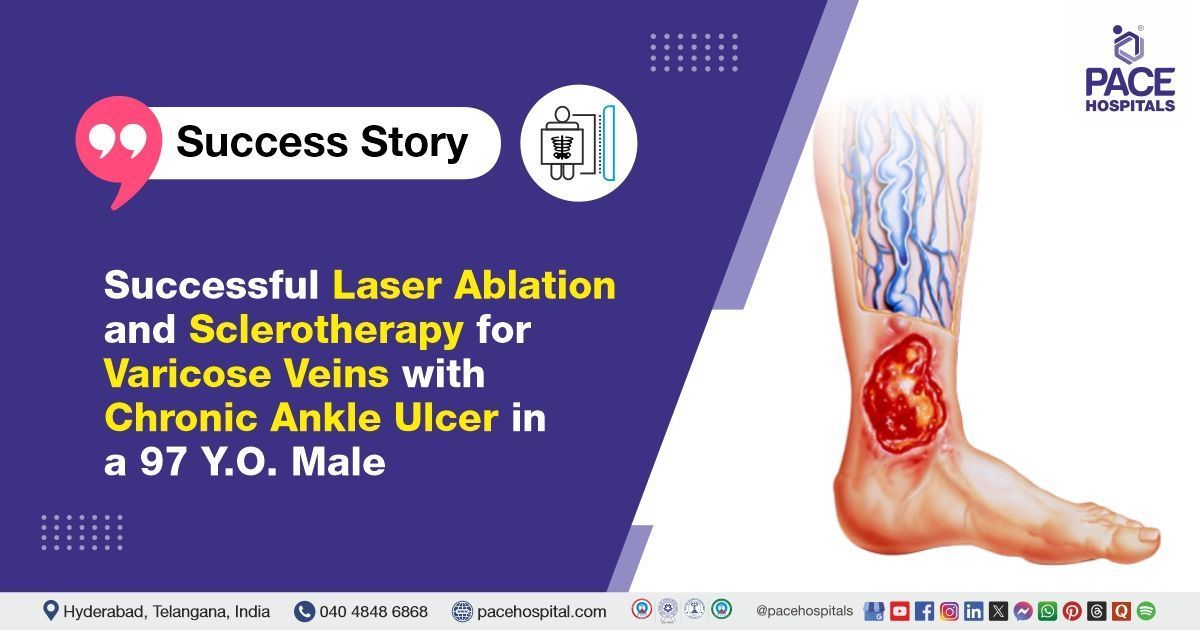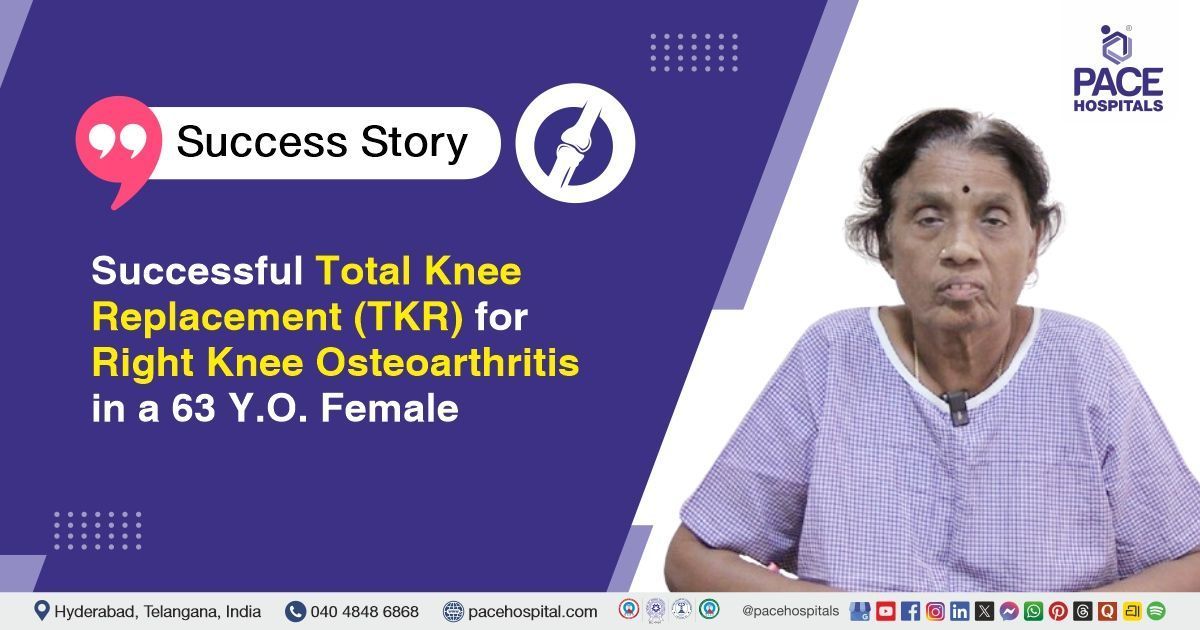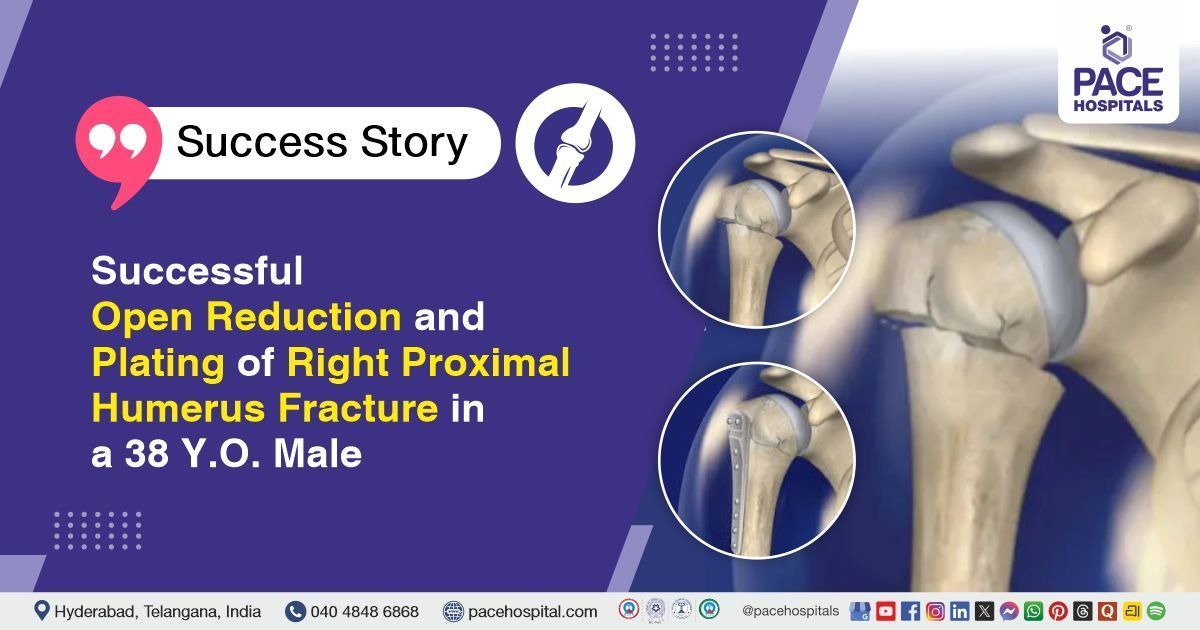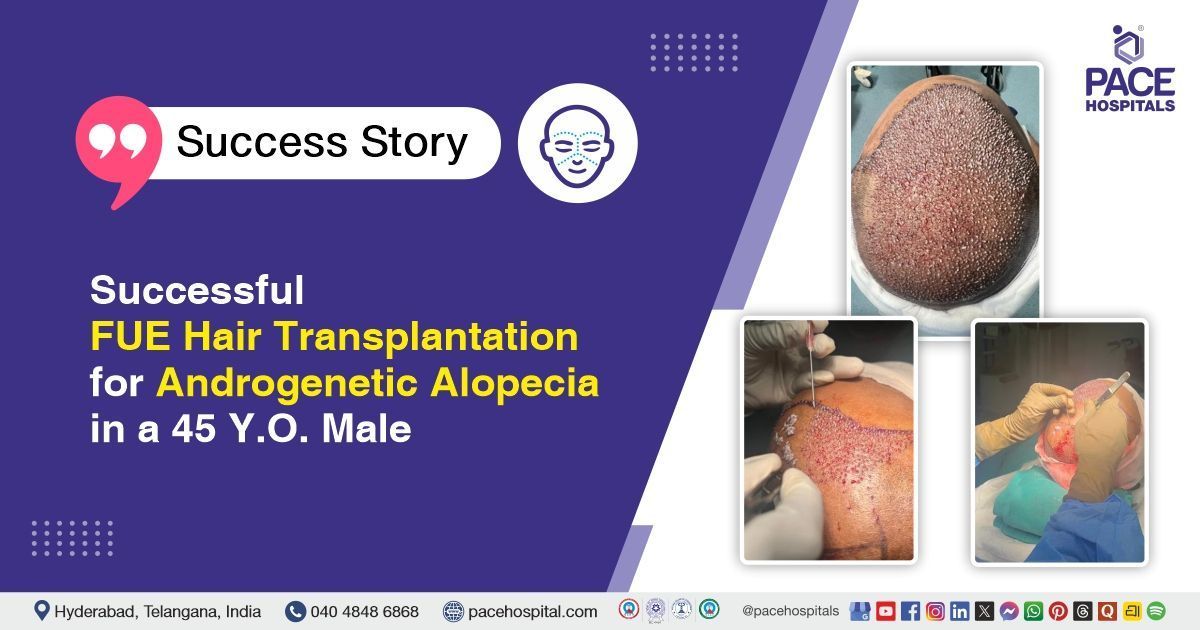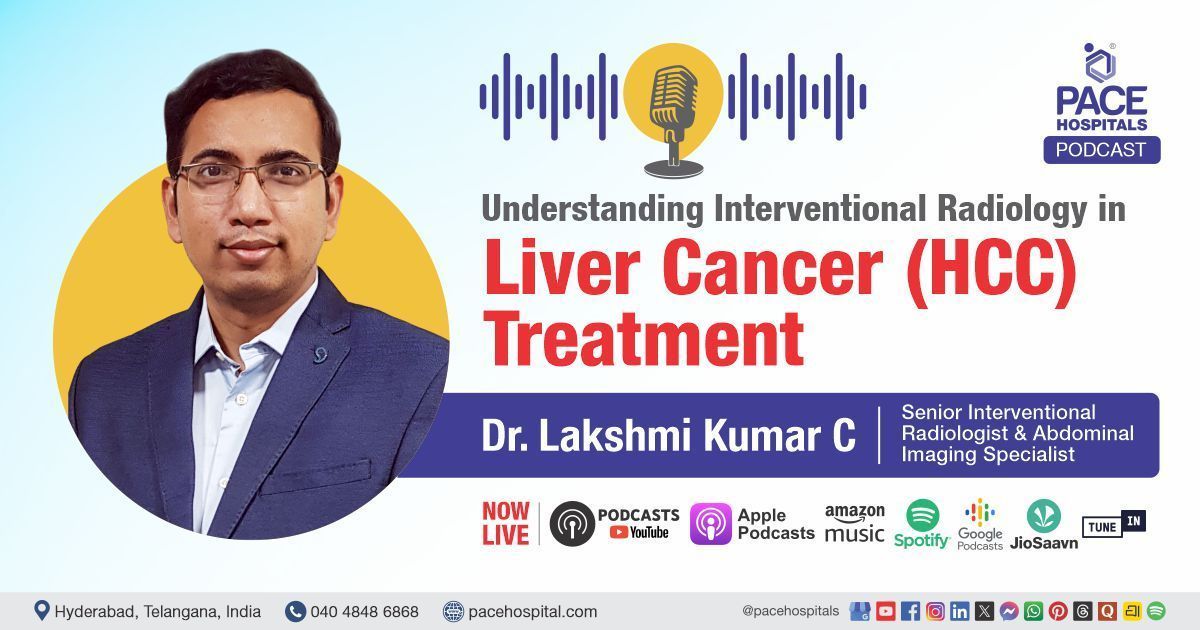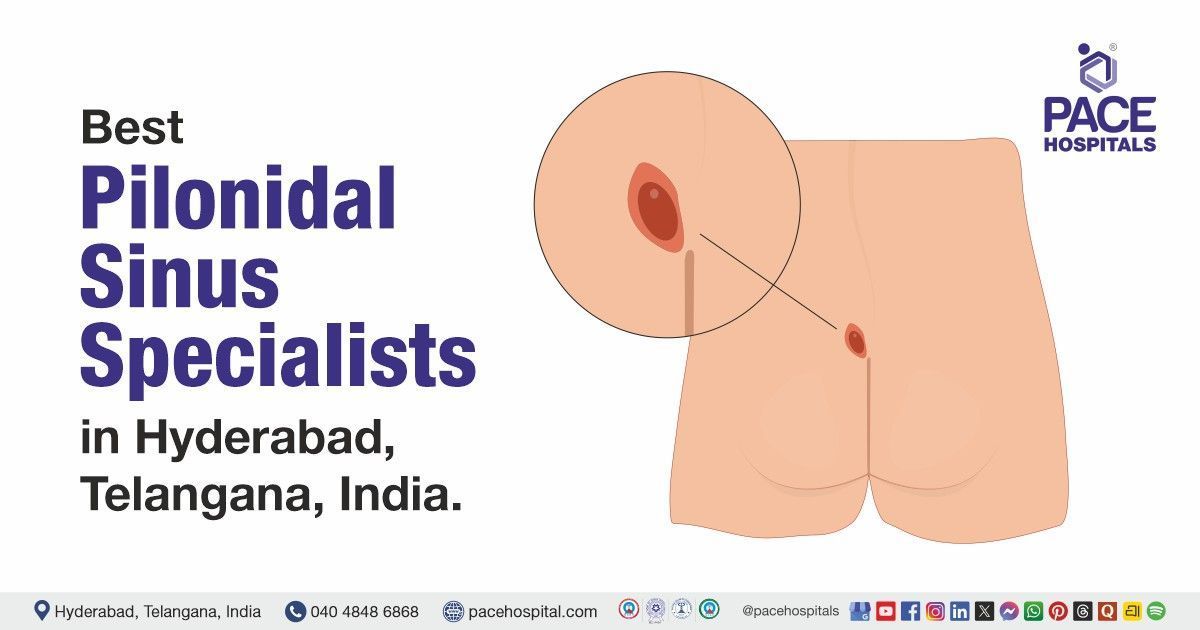Successful Laser Ablation and Sclerotherapy for Varicose Veins with Chronic Ankle Ulcer in a 97 Y.O. Male
PACE Hospitals
PACE Hospitals Expert Interventional Radiology Team successfully performed left Great Saphenous Vein (GSV) and Small Saphenous Vein (SSV) laser ablation combined with sclerotherapy on a 97-year-old male patient with a non-healing ulcer on the left ankle caused by varicose veins and peripheral vascular disease (PVD). The aim of the procedure was to close the faulty superficial veins to improve venous circulation, promote healing of the ulcer, relieve symptoms, and prevent further complications.
Chief Complaints
A 97-year-old male patient with a
body mass index (BMI) of 23 presented to the Interventional Radiology Department at
PACE Hospitals, Hitech City, Hyderabad, with a non-healing ulcer on the left ankle, persisting for five years and associated with discharge.
Past Medical History
The patient was a known case of varicose veins, hypertension, diabetes, and hypothyroidism, all of which were under treatment. He had a history of varicose vein surgery and had undergone skin graft surgery three years prior. The patient also had a history of smoking and alcohol consumption.
On Examination
On examination, the patient was alert, oriented, and cooperative. There were no visible signs of pallor,
jaundice, cyanosis, clubbing, lymphadenopathy, or edema. Vital signs were within normal limits.
Diagnosis
Following the clinical examination, the Interventional Radiology team conducted a comprehensive assessment, which included a detailed review of the patient’s medical history and a focused clinical evaluation. Diagnostic tests performed included blood investigations, an electrocardiogram (ECG), and a color Doppler ultrasound of the lower limbs to assess venous reflux, valve competence, and the extent of venous dilation.
Blood investigations were within normal limits except for elevated blood sugar consistent with known diabetes. The ECG showed a normal sinus rhythm without abnormalities. Color Doppler ultrasound revealed abnormal reflux and incompetence of the superficial venous system, specifically involving the left Great Saphenous Vein (GSV) and Small Saphenous Vein (SSV), with significant venous dilation.
Considering the patient's clinical symptoms, physical examination findings, and Doppler ultrasound results, a diagnosis of a non-healing ulcer of the left ankle with varicose veins and peripheral vascular disease (PVD) was established.
Based on the confirmed diagnosis, the patient was advised to undergo
Non-healing Ulcer and
Varicose Veins Treatment in Hyderabad, India, under the care of the Interventional Radiology Department to ensure comprehensive management of his condition.
Medical Decision Making
After consultation with Dr. Lakshmi Kumar Chalamarla, Interventional Radiologist, and cross consultations include Dr. Kantamneni Lakshmi, Dr. Seshi Vardhan Janjirala, Dr. Mounika Jetti, Dr. Pradeep Kiran Panchadi, Dr. Shiva Shankar Marri a thorough evaluation was undertaken to determine the most suitable diagnostic and therapeutic strategy for the patient’s venous condition.
Following a detailed assessment, including clinical correlation and imaging findings, it was concluded that conservative management alone would be insufficient to promote healing of the chronic ulcer and alleviate venous insufficiency.
Based on their expert assessment, it was determined that laser ablation of the left Great Saphenous Vein (GSV) and Small Saphenous Vein (SSV), combined with sclerotherapy, was identified as the most effective procedure to address the patient’s condition, improve venous circulation, and prevent further complications.
The patient and his family members were thoroughly counselled about the severity of the condition, the planned minimally invasive procedure, potential risks including infection and recurrence, and the necessity for timely intervention to optimise outcomes.
Surgical Procedure
Following the decision, the patient was scheduled to undergo Laser Ablation of the Left Great Saphenous Vein (GSV) and Small Saphenous Vein (SSV), combined with sclerotherapy Surgery in Hyderabad at PACE Hospitals under the supervision of the expert Interventional Radiology Department.
The procedure involved the following steps:
- Preparation and Anesthesia: Under strict aseptic conditions, the patient was prepared for the procedure. Spinal anesthesia (S.A) was administered along with tumescence anesthesia to ensure adequate pain control and local tissue tumescence for better laser fiber delivery and vein closure.
- Ultrasound Guidance and Vein Identification: Using real-time ultrasound guidance, the left great saphenous vein (GSV) and small saphenous vein (SSV) were precisely identified. This imaging allowed accurate positioning of the laser fiber within the target veins, ensuring effective ablation while minimizing damage to surrounding tissues.
- Laser Ablation of GSV and SSV: A radial laser fiber was carefully inserted into the left GSV and SSV. Controlled laser energy was delivered along the length of the veins to induce thermal injury, leading to vein closure and subsequent fibrosis. The ablation was performed meticulously to treat the incompetent veins responsible for the patient’s venous insufficiency.
- Foam Sclerotherapy of Varicosities: In addition to laser ablation, several residual varicosities were treated with anionic surfactant foam sclerosant. This was injected under ultrasound guidance into the affected superficial veins, causing endothelial damage and obliteration of these smaller varicose veins.
- Completion of Procedure: The procedure was uneventful without any immediate complications. An aseptic skin closure device (ASD) was applied at the access site, followed by the application of a crepe bandage to provide compression and support to the treated limb, promoting healing and reducing the risk of postoperative complications.
Postoperative Care
Postoperative care was uneventful. During the hospital stay, the patient was administered antibiotics for infection control, proton pump inhibitors for gastric protection, analgesics for pain relief, and antiemetics as needed. Anticoagulants were given to prevent thromboembolic events. Blood sugar control was managed using oral hypoglycemic agents. Antihypertensive medications were continued to manage blood pressure. Vasodilators and vascular protective agents were prescribed to improve circulation.
Thyroid hormone replacement therapy was maintained for hypothyroidism. For local care, emollient lotions were applied to address skin dryness and itching, corticosteroid preparations were used as required for inflammation, and bronchodilators were administered for respiratory support. A medicated soap was used for gentle bathing, and topical antibiotics were applied to the ulcer site for local infection control.
Discharge Medications
Upon discharge, the patient was prescribed oral antibiotics for infection prevention, proton pump inhibitors to protect the gastrointestinal tract, and oral analgesics for pain relief. Anticoagulants were continued to reduce the risk of thromboembolism. Oral hypoglycemic agents were maintained for blood sugar control, and antihypertensive medications were prescribed for blood pressure management.
Vasodilators and vascular protective agents were advised to improve peripheral circulation. Thyroid hormone replacement therapy was continued for hypothyroidism. For local care, emollient lotions were recommended to relieve skin dryness, topical corticosteroids were prescribed to manage itching and inflammation, and topical antibiotics were used for infection control at the ulcer site.
Advice on Discharge
The patient was advised to undergo daily wound dressings, apply a crepe bandage for local support, and maintain limb elevation. A diabetic diet was recommended to support overall health and wound healing. The patient was advised to collect the Histopathological Examination (HPE) report for further evaluation.
Emergency Care
The patient was informed to contact the emergency ward at PACE Hospitals in case of any emergency or development of symptoms like fever, leg swelling, severe leg pain, and itching.
Review and Follow-up Notes
The patient was advised to return for a follow-up visit with the Interventional Radiologist in Hyderabad at PACE Hospitals, after one week. Additionally, a review with the Plastic Surgery OPD was scheduled after one week for evaluation of the biopsy report, both requiring prior appointments. Follow-up consultations were also arranged with the Pulmonologist after 10 days and with the Dermatology OPD after 20 days, each with prior appointments.
Conclusion
This case highlights the complexity of managing a chronic non-healing ulcer in an elderly patient with multiple comorbidities. It underscores the importance of a multidisciplinary approach involving interventional radiology, dermatology, pulmonology, and plastic surgery to optimize diagnosis and treatment. Timely intervention with minimally invasive procedures and coordinated follow-up is crucial for improving patient outcomes.
The Importance of Multidisciplinary Care in Complex Wound Management
Effective management of complex wounds requires a multidisciplinary approach involving specialists from various fields to address both local and systemic factors. Combining advanced therapeutic techniques with comprehensive medical management can significantly improve healing outcomes and reduce the risk of complications. Patient education and counseling are essential to ensure adherence and optimize recovery. Tailoring treatment plans to individual patient needs, especially in the presence of comorbidities, enhances overall care quality and supports long-term health.
Coordination among healthcare providers, including the interventional
radiologist / interventional radiology doctor, facilitates timely interventions and better monitoring of progress. Ultimately, this holistic strategy fosters improved patient satisfaction and reduces healthcare costs by minimizing hospital stays and preventing recurrence.
Share on
Request an appointment
Fill in the appointment form or call us instantly to book a confirmed appointment with our super specialist at 04048486868

